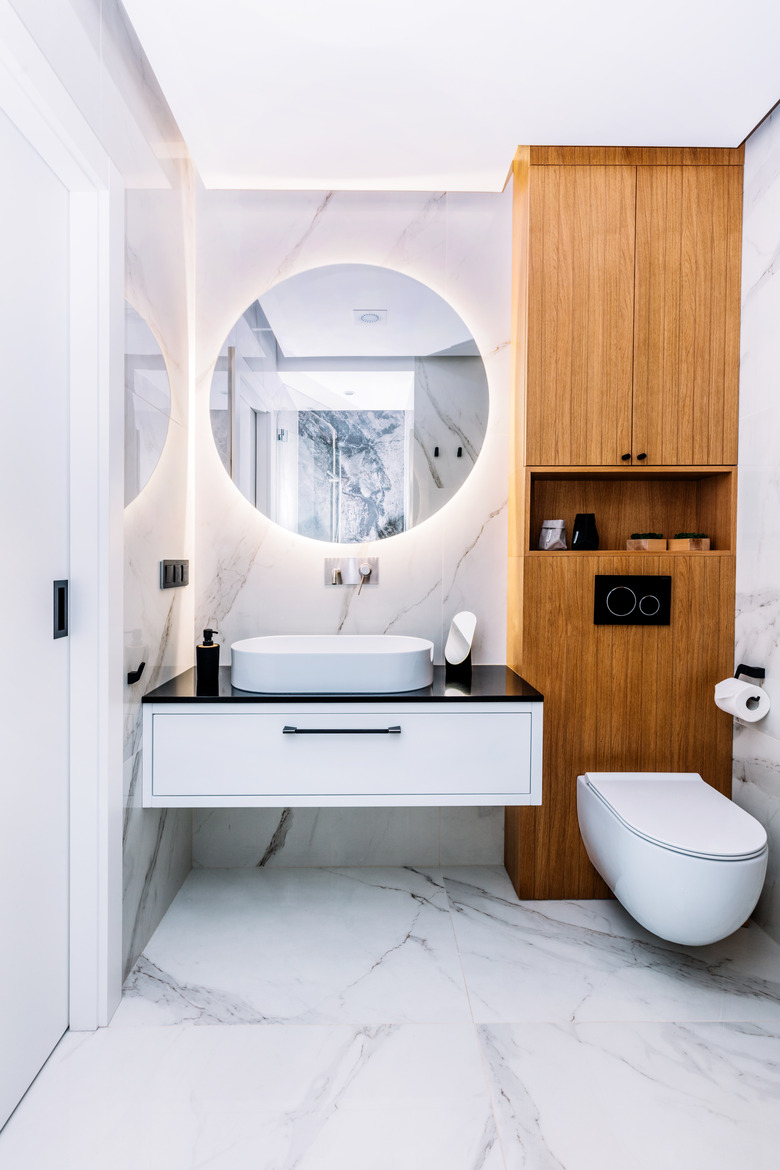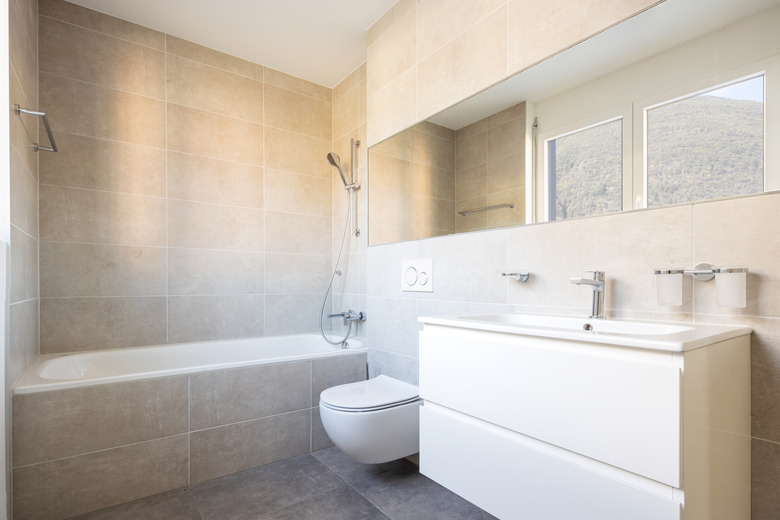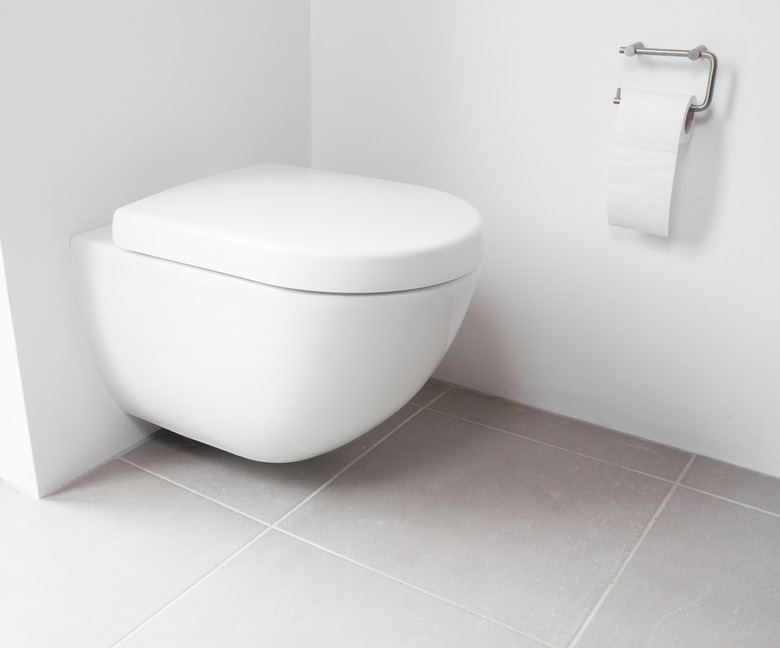Wall-Mounted Toilets: What You Need To Know
While fairly common in European dwellings, the wall-mounted toilet is starting to catch on in North American homes as well. These space-saving toilets may cost a bit more than their standard floor-mounted counterparts, but many homeowners enjoy the sleek look.
Wall-Mounted Toilets vs. Standard Toilets
Wall-Mounted Toilets vs. Standard Toilets
A wall-mounted toilet is different from toilets that mount on the floor because the entire tank, or cistern, sits inside the wall. It's a completely separate unit from the bowl and is often sold separately. As its name implies, a wall-hung toilet attaches to hardware hidden in the wall and doesn't touch the floor at all.
Wall-mounted toilets also save water when compared to old models of floor-mounted toilets, although the water usage of current toilets of both wall and floor varieties is virtually identical. As with floor-mounted toilets, some wall-mounted toilets offer a dual-flush feature to save even more water. Though the wall-hung toilets function in much the same way, their parts look a bit different. The tank is made of plastic and foam and is held in place with a sturdy metal framework that is sold along with it. The flushing mechanism is a button instead of a handle.
The terminology used with wall-mounted toilets is different as well. The tank is called a cistern, and the flush button, which is mounted on the wall, is called a flush actuator. The plate that goes on the wall around the flush actuator may be called an access panel, as it can be removed to adjust the water level.
Wall-Mounted Toilet Benefits
Wall-Mounted Toilet Benefits
A wall-mounted toilet offers a few benefits when compared to the more common floor-mounted variety. Since a wall-hung toilet doesn't touch the floor, it's much easier to keep the floor clean. There's no more mopping or sweeping up to the bottom edge of the toilet, so you can clean the area beneath a wall-hung toilet with ease. A wall-mounted toilet also offers the opportunity to hang the toilet so the seat sits at the height you prefer, generally within the 15- to 28-inch range when measured from the floor to the top of the seat. With standard toilets, the options for various heights are more limited.
Wall-hung toilets also save floor space from back to front compared to a floor-mounted toilet since the tank sits inside the wall. This can be ideal for a small bathroom where every inch of floor space matters. In some cases, a wall-mounted toilet can save up to 12 inches compared to standard toilets made by the same company, according to Kohler.
Even with the plumbing tucked into the wall, the toilet tank's inner workings are still easy to access by removing the flush panel, although this varies a bit depending on the model and brand. Since most of the toilet's parts and plumbing are hidden in the wall, the end result is a more sleek, streamlined look that would be right at home in a luxury hotel room.
Wall-Mounted Toilet Cons
Wall-Mounted Toilet Cons
While a wall-mounted toilet has a few advantages, it has just as many drawbacks for the average household bathroom designed to house a floor-mount toilet. The toilet bowl itself may be in the same price range as a standard floor-mount toilet, but in most cases, the in-wall tank setup is sold as a separate unit that costs as much as the toilet bowl, making the cost for all pieces more than that for a similar floor-mounted version.
If your bathroom is set up for a standard floor-mounted toilet, the plumbing most likely has to be rerouted to accommodate a wall-mounted toilet. This is a job for a licensed plumber. Without the old floor-mount toilet in place, the floor in that area also needs repairs to match the rest of the bathroom floor.
Installing the toilet tank setup in an existing bathroom also means cutting into the wall and tearing it down to the studs in the area of the installation. Installation may be fairly simple for new construction or during major bathroom renovation, but for an existing bathroom, this home improvement project is far more involved and more expensive than simply swapping one floor-mount toilet for another.
Over time, a wall-mounted toilet may become a bit loose. This requires tightening the nuts that hold the toilet onto the bolts on its framework in the wall. Check that the toilet is level before tightening the bolts; if it is not level, the toilet could rock a bit when in use, which could also cause it to loosen.
Wall-Hung Toilet Costs
Wall-Hung Toilet Costs
For the parts alone, wall toilets cost up to $1,000 or at the very least several hundred more than a floor-mounted toilet with similar looks and features. Even though retailers list some wall-mounted toilets in the $200 to $300 range, that price usually does not include the in-wall carrier/tank assembly and hardware or even the flush actuator. It may not even include the toilet seat.
Expect to pay $650 to $800 on average for the in-wall tank and carrier system. If the flush actuator plate isn't included, add another $150 or so to the price. All of this is for the required toilet parts alone and not for installation, rerouting any pipes or the costs to repair the floor and wall. These costs may vary significantly depending on the difficulty of the project and the location of existing pipes.
On average, it costs around $375 for a plumber to replace a toilet with a similar model (i.e. replacing a wall-mount toilet with a new wall-mount toilet). Moving the plumbing and venting lines could add hundreds or even thousands to the labor cost depending on the situation and the region. Contact a reliable local plumber for a realistic estimate based on your bathroom layout.
Wall-Mounted Toilet Installation
Wall-Mounted Toilet Installation
Assuming the waste pipe and plumbing for the toilet are where they need to be within the project wall and that the project wall is already open to expose the studs, installing a wall-mounted toilet still requires some work that's different from installing a floor-mounted toilet. Once installed, however, the toilets function in the same manner.
In many cases, you'll have to assemble the cistern framework and attach the cistern before installing these in the wall. The metal frame pieces are fairly easy to put together yourself following the instructions that came with the cistern package. Assembly may also include attaching feet to the vertical portion of the framework as well as hardware to connect the cistern to the waste pipe in the house. Once the cistern is in place in its framework, attach the framework to wall studs as indicated in the manufacturer's instructions, which vary from one brand to the next.
The toilet bowl attaches to the framework with nuts and bolts and can be placed at a height that works well for your household. Make sure the bowl is completely level during installation. The movable parts that control the water level and flushing mechanism also have to be attached according to the manufacturer's instructions, as does the water line.
Wall-Mounted Toilet Repairs and Maintenance
Wall-Mounted Toilet Repairs and Maintenance
Even if you aren't able to access the in-wall plumbing through a removable wall piece in the bathroom or in the room behind it, many minor toilet issues are easy to handle without opening the wall. The panel that houses the flush actuator comes off, allowing access to the in-wall cistern and the mechanisms that control the flush and the water level.
- Look for a plastic valve spindle after removing the panel. Rotate the spindle counterclockwise one full turn to lower the water level in the toilet bowl.
- Rotate the spindle one turn clockwise to raise the water level in the toilet bowl. If the toilet doesn't flush thoroughly, it usually means that the bowl needs more water.
- If the cistern itself is leaking within the wall, it may be cracked. If it is cracked, the cistern must be replaced, as is the case with a standard floor-mount toilet with a cracked tank.
- If the toilet bowl is leaking into or near the wall, either the bowl is cracked or the seal needs to be replaced. Wall-mount toilets use a slightly different seal or ring than floor-mount toilets; check the toilet manufacturer's website or installation instructions regarding the best type for the job, typically rubber or felt. Replacing the ring means turning off the water, removing all the water from the toilet and taking the toilet off the wall to access the ring.


